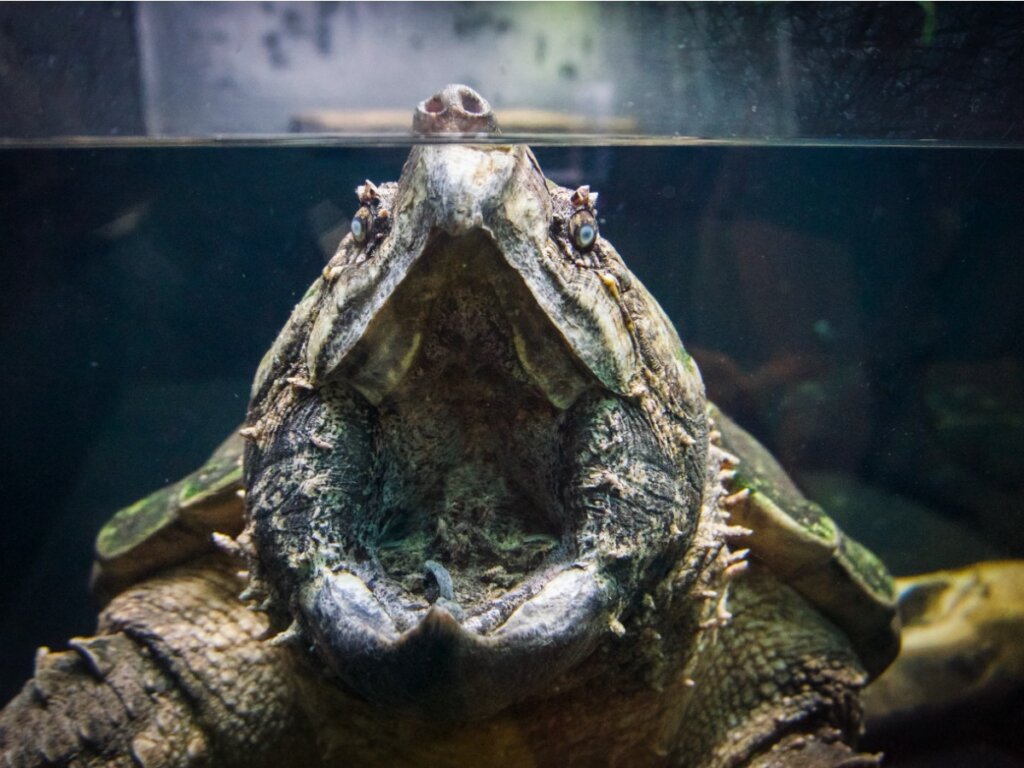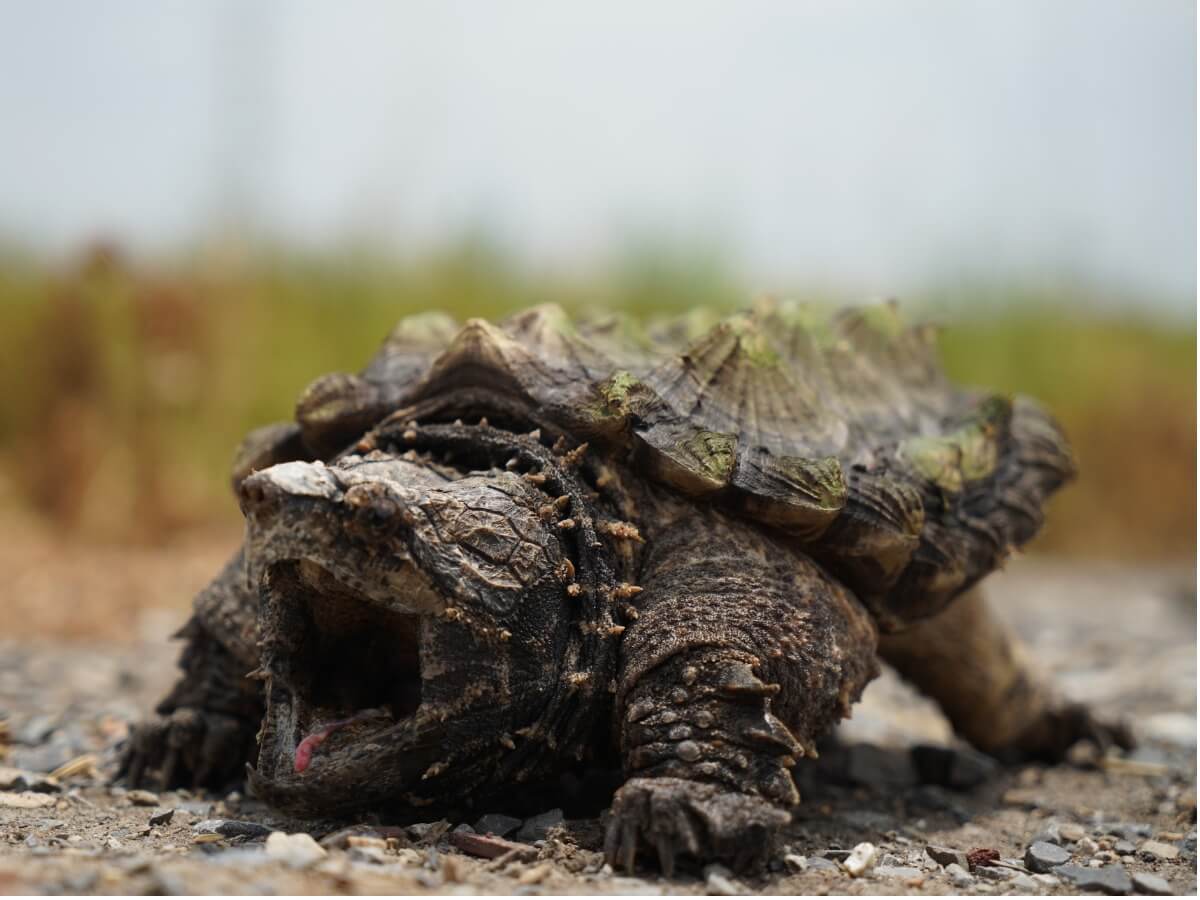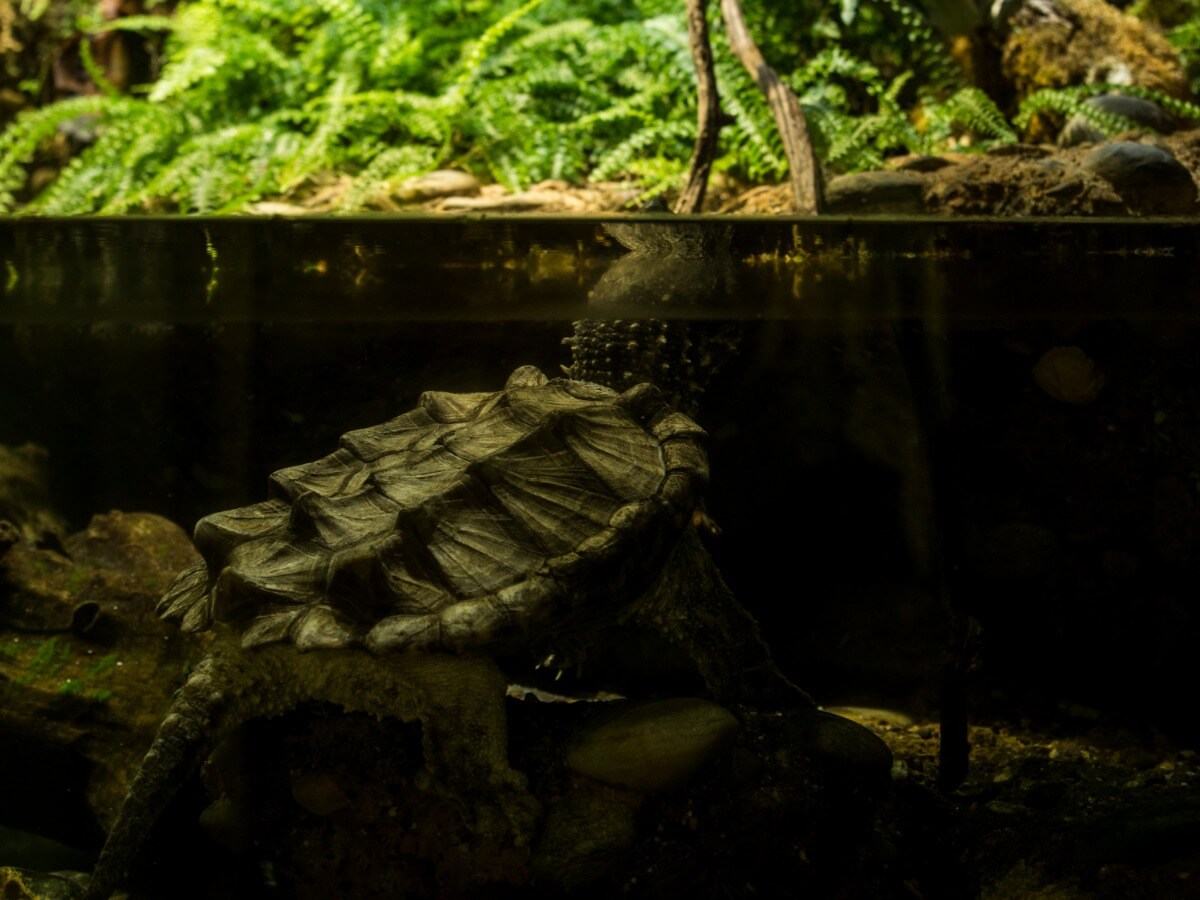Alligator Snapping Turtle: Habitat and Characteristics

When we hear the word “turtle”, the image of a beautiful reptile with a shell comes to mind, however, there’s a species that looks more like a small dinosaur. The alligator snapping turtle (Macrochelys temminckii) has physical characteristics that are quite reminiscent of an alligator or crocodile, due to the fact that it has several peaks and elevations along its body.
As if its appearance weren’t enough, this reptile has a powerful bite that can cause damage to the tissues of any vertebrate. It’s quite large and robust, and it’s capable of doing a lot of damage if you disturb it. Read on and learn more about this fascinating yet dangerous species.
Characteristics of the alligator snapping turtle
The alligator snapping turtle can exceed 80 kilograms in weight and is capable of living up to 70 years in captivity. Its body is covered in scales and bony plates, which have beak-shaped constrictions. On the other hand, its shell has 3 rows of spikes along its body, which gives the animal a spiny and archaic appearance.
The length of its body can reach about 75 centimeters (2.5 feet) and its tail stands out for being thick and long. The shell of the species reaches around 30 centimeters (1 foot), so some parts of its body don’t have any protection. However, this chelonian is armed with sharp claws and a strong beaked jaw, and so its armor isn’t its only defense.
The turtle’s colors are dark and range from gray-brown to olive-green. Because it inhabits river currents, its body is often lined with algae.

How does it live?
This reptile’s way of life is centered on maintaining its position within the water currents, as this is where it gets most of its food. Its physical form gives it an advantage, because it’s easily confused with the forms on a river bed. Despite this, it moves considerably in water and designates resting places to be able to take shelter.
It isn’t a migratory species, and so its habitat is quite limited. Despite spending most of its life in water, it lays its eggs on land. Due to its characteristics, it’s considered to be a predator of the highest trophic level, which means that it has very few enemies as an adult.
How does it feed itself?
This species is carnivorous during the first stages of life. However, as it develops, it widens its nutritional spectrum and reaches omnivory status. Its diet is made up of various fish, birds, insects, amphibians, mammals, crustaceans, and even other turtles.
These chelonians don’t have a preference for any one type of meat, as in captivity they can eat any meat compound, including carrion.
This animal’s mouth has developed a special characteristic to attract and hunt fish. The tip of the tongue is similar to the appearance of a worm with the aim of tricking the fish into getting closer. During the action, it remains immobile at the bottom of the water with its mouth open, and when its prey arrives, it delivers a quick, accurate, and lethal bite.
This reptile hunts preferably at night, almost like a nocturnal species. However, it’s also active during the day, which is why some classify it as an opportunistic species.
Reproduction
The alligator snapping turtle is an oviparous species, which does not reach sexual maturity until between 11 and 17 years of age. Males are usually larger than females. Their nests hold approximately 35 eggs per laying, but they have a high probability of being eaten by predators. This is one of the reasons why their numbers have diminished.
In 2013, the Department of Biology and Museum of Natural History at the University of Louisiana conducted an experiment to learn about the predation suffered by these animals. This team found that all of their shelters were destroyed and the eggs became food for other animals. These results aren’t unusual, because, depending on the season, only 20% of the offspring – at most – are born.
As if that weren’t enough, out of all those that manage to hatch, only around 20% of them reach “adolescence”. Because of this, nest protection has been proposed as a means to prevent population decline and a possible extinction of the species.
The sex of these turtles is determined by the temperature at which the eggs are incubated. In addition, their development in hot waters above about 30° C makes them grow faster.
Distribution of the alligator snapping turtle
The alligator snapping turtle is an aquatic species native to rivers in the United States. It’s restricted to bodies of water that flow into the Gulf of Mexico, and so its distribution ranges from Florida to eastern Texas, through Arkansas, Georgia, Louisiana and Oklahoma.
It’s considered the largest freshwater species in the area, although it has endured decades of human predation. The population of this reptile has decreased to levels that are beginning to become a cause of alarm, due to the demand for its meat and the typical dishes of some areas, such as turtle soup.
Can you have an alligator snapping turtle as a pet?
Although it may seem like an ideal exotic pet for giant aquariums, keeping an alligator turtle in the home is not recommended. Characteristics such as its size and weight play a very important role when it comes to thinking about the requirements for this animal to have a full life. For this reason, it’s recommended to opt for some other species of turtle as a pet.
The extent of their habitat must include both water and land. In addition to this, the environment must have vegetation, fish, rocks, and a constant flow of water. That’s why only specialized protection centers, natural parks, or zoos are capable of bearing the responsibility of maintaining and raising specimens of alligator snapping turtles in the long term.
In addition, in terms of its conservation, this species is classified as vulnerable. This situation is due to their history of overexploitation – by humans – and to problems with their habitat and reproduction. Fortunately, there are already various projects to help protect it from extinction, so all isn’t lost yet.
In certain regions it’s directly forbidden to keep this species at home without permits, due to the size it reaches and the power of its bite.

Despite its deadly jaws, this species doesn’t stand out for its aggressiveness. However, great care must be taken if you do have an encounter with one, as its jaw is capable of breaking bones. As long as you don’t attack or try to handle it, you’ll be safe. Respect for nature is the most important thing here.
All cited sources were thoroughly reviewed by our team to ensure their quality, reliability, currency, and validity. The bibliography of this article was considered reliable and of academic or scientific accuracy.
- Sheil, C. A. (2005). Skeletal development of Macrochelys temminckii (Reptilia: Testudines: Chelydridae). Journal of Morphology, 263(1), 71-106.
- Riedle, J. D., Shipman, P. A., Fox, S. F., & Leslie Jr, D. M. (2006). Microhabitat use, home range, and movements of the alligator snapping turtle, Macrochelys temminckii, in Oklahoma. The Southwestern Naturalist, 35-40.
- Baker, S., Kessler, E., Darville-Bowleg, L., & Merchant, M. (2019). Different mechanisms of serum complement activation in the plasma of common (Chelydra serpentina) and alligator (Macrochelys temminckii) snapping turtles. PloS one, 14(6), e0217626.
- Chaffin, K., Norton, T. M., Gilardi, K., Poppenga, R., Jensen, J. B., Moler, P., … & Mazet, J. (2008). Health assessment of free-ranging alligator snapping turtles (Macrochelys temminckii) in Georgia and Florida. Journal of wildlife diseases, 44(3), 670-686.
- Jensen, J. B., & Birkhead, W. S. (2003). Distribution and status of the alligator snapping turtle (Macrochelys temminckii) in Georgia. Southeastern Naturalist, 2(1), 25-34.
- Elsey, R. M. (2006). Food habits of Macrochelys temminckii (alligator snapping turtle) from Arkansas and Louisiana. Southeastern Naturalist, 5(3), 443-452.
- Alhaboubi, A. R., Pollard, D. A., & Holman, P. J. (2017). Molecular and morphological characterization of a haemogregarine in the alligator snapping turtle, Macrochelys temminckii (Testudines: Chelydridae). Parasitology research, 116(1), 207-215.
- Lescher, T. C., Briggler, J. T., & Tang-Martínez, Z. (2013). Relative abundance, population structure, and conservation of alligator snapping turtles (Macrochelys temminckii) in Missouri between 1993–1994 and 2009. Chelonian Conservation and Biology, 12(1), 163-168.
- Holcomb, S. R., & Carr, J. L. (2013). Mammalian Depredation of Artificial Alligator Snapping Turtle (Macrochelys temminckii) Nests in North Louisiana. Southeastern Naturalist, 12(3), 478–491. doi:10.1656/058.012.0303
- Trauth, S., Farris, J., & Rauschenberger, R. H. (2004). Incubation of alligator snapping turtle (Macrochelys temminckii) eggs in natural and agricultural soils. Applied Herpetology, 1(3-4), 299-309.
